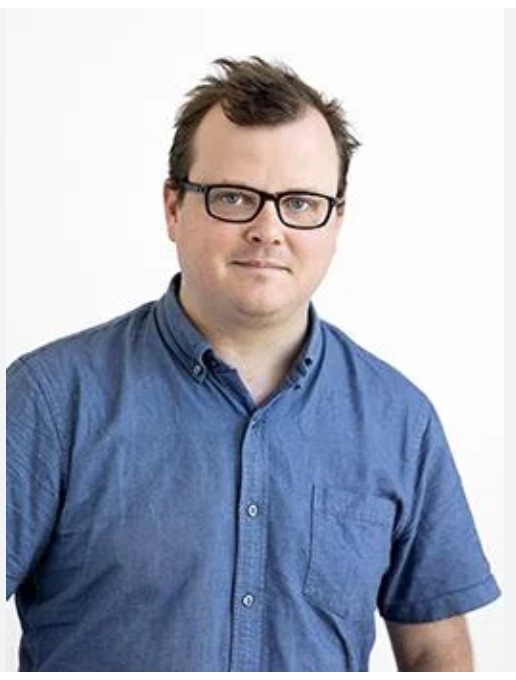by Mike Telin

“The discovery caused a sensation. The impulses were so regular that for a while they were taken to be signals coming from extraterrestrial civilisations. Then astrophysicists revealed a truth that was just as surprising: the signals were being emitted by a pulsar, the fantastic compact residue created by the supernova explosions that long ago disintegrated the massive stars.”
This discovery served as the inspiration for Gérard Grisey’s Le Noir de l’Étoile. Commissioned by the French State and Les Percussions de Strasbourg, the piece was premiered in 1991 at the Ars Musica Festival in Brussels.
On Monday, April 8 at 1:00 pm, Oberlin Percussion Group, under the direction of Ross Karre (pictured), will perform Grisey’s monumental work in Hales Gymnasium. The free performance is part of Oberlin’s OCLIPSE Concert Series celebrating the solar eclipse set to take place on Monday. Click here to learn more about Le Noir de l’Étoile.
“The piece immediately came to mind when the faculty were asked to think of programming ideas for the day of the eclipse,” Karre said during a telephone conversation.
Le Noir de l’Étoile was conceived as a composition that is in tune with the rotational movement of celestial bodies, specifically pulsars, or dying stars that are spinning. As they slow down, they emit electromagnetic impulses that can be detected by radio signals, and that creates a rhythm. And those rhythms are musically transformed into a kind of counterpoint and polyrhythms by Gérard Grisey. So I think on this occasion where the nearest celestial bodies are coming into a special orbit and alignment, it makes perfect sense to listen a little further into space.”
Karre noted that Le Noir de l’Étoile is one of the most difficult percussion pieces ever composed because of its scale and the sheer feats of speed it takes to perform it. “Sometimes the recorded pulses are emitting at 14 cycles per second, and for a percussionist it is really hard to make a roll at that speed. But it’s something that the students have eagerly taken on, and they’ve exceeded all expectations.” Following Monday’s performance, Oberlin Percussion Group will bring the piece to Interlochen Center for the Arts.
The hour-long work calls for six percussion stations surrounding the audience, with a click track used for coordination. “It’s rather straightforward to practice. You slow down the track to get used to the rhythms and gradually speed it up.”
How many instruments in total does it take to play the piece? “I wish I knew the exact number but it’s hundreds of instruments, which is nuts,” Karre said. “The drum collection alone is over 42, because there are at least seven drums for each of the six players. Then there are fifteen tuned gongs as well as six untuned — tam-tams. And then 24 tuned pieces of wood — in our case we’re using hardwood slabs.” He added that the piece also requires little sounds produced by scrub brushes, ball mallets, and jazz brushes.
Regarding the electronic sounds, Karre pointed out that there is very little overlap between the acoustic instruments and the electronics, which include a spoken-word opening. “The piece begins with a semi-poetic lecture about the pulsars. It takes about five minutes but it gives the audience a more scientific framework without losing any of the poetic expression.”
After that the bass drums begin to enter like a heartbeat from the cosmos. And at the apex there is a field recording of one pulsar in isolation — just one pulsar — before the percussion returns. “There’s a little bit of overlap between the percussion and two other pulsars. There’s also a moment where the percussion has stopped during a three-minute pulsar before they come back in. So it’s not quite like an electroacoustic piece where we play along with the pulsar — just a little bit of that.”
Karre said that it is Grisey’s intricate sound palette, “drawing attention to the different parts of an individual sound,” that makes the piece so fascinating. “He creates a harmonic composite that’s about the difference between sounds — wooden, metallic, drum membrane, hollow, full lumina — and the kinds of characteristics that each of those have. And for percussionists, when a composer takes that much interest in our sound, that’s kind of our kid-in-the-candy-shop moment.”
Seating for the audience will be arranged in three or four concentric circles in Hales Gym with plenty of room for people to walk around and change their orientation to the piece, or take a seat on the floor.
“I think the spirit of the day will be very ambulatory, because immediately following our performance, artists from TIMARA [Technology in Music and Related Arts] and the cinema and dance departments are presenting a work in Tappan Square. And then we’ll head to the football field with our special glasses. So it’s like a continuum of experiences.”
At 2:00 pm in Tappan Square, Raphael Sacks and Geneva Cockrell of the Loom Ensemble will co-direct a theatrical performance in celebration of the total eclipse. Additionally, composer, sound artist, and instrument builder Daniel Fishkin will be presenting his Solar Sounders, light-reactive synthesizers. The event is free. Read Sloane DiBari’s preview article on Obie Muse.
Published on ClevelandClassical.com April 3, 2024.
Click here for a printable copy of this article


